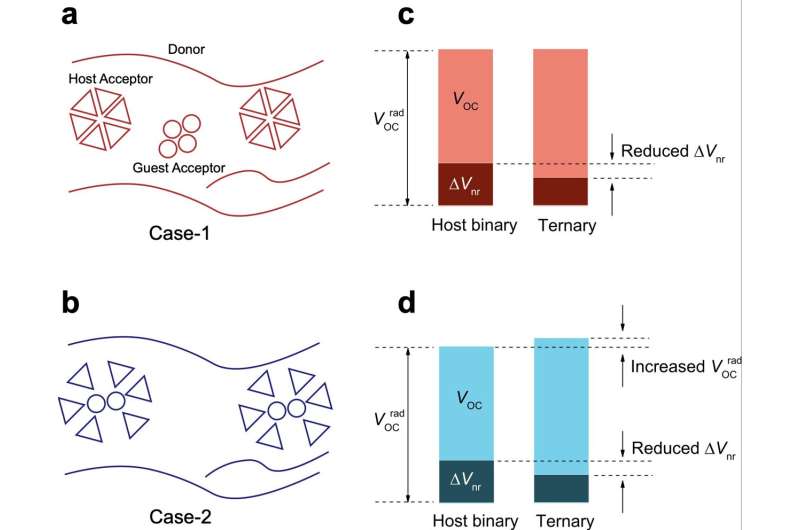August 21, 2023 feature
This article has been reviewed according to Science X's editorial process and policies. Editors have highlighted the following attributes while ensuring the content's credibility:
fact-checked
peer-reviewed publication
trusted source
proofread
New strategies to minimize voltage losses in ternary organic solar cells

Ternary organic solar cells, in which the photoactive layer is made of three different organic materials, have been found to achieve highly promising power conversion efficiencies (PCEs). While these ternary organic solar cells could have notable advantages over their corresponding binary counterparts, their performance is still adversely impacted by large open-circuit voltage losses.
Researchers at Linköping University, Hasselt University, IMEC and other institutes recently carried out a study aimed at better understanding the origins of this loss of voltage in ternary organic solar cells. Their paper, published in Nature Energy, outlines two viable design strategies that could help to minimize these voltage losses.
"The initial motivation of our recent research was to investigate how the third component affects non-radiative recombination voltage loss in the ternary organic solar cells," Yuming Wang, one of the authors of the paper, told Tech Xplore. "This was inspired by results from our previous collaborations, which were focused on the voltage losses in the non-fullerene based organic solar cells, with the other chemistry groups."
"As the project progressed, we realized that substantial debates still revolved not only around the mechanisms underpinning non-radiative recombination voltage loss, but also encompassed the broader subject of the adjustable open-circuit voltage of ternary organic solar cells."
The recent study carried out by Wang and his colleagues underwent a gradual change of objective as the team progressed with their investigation. Initially, they had started investigating the voltage losses in non-fullerene based organic solar cells, they ultimately ended up focusing on the mechanisms underpinning the adjustability of the open-circuit voltage in ternary organic solar cells.
"Our investigations were based on the equations derived from the detailed balance principle," Wang explained. "To obtain the parameters included in the equations, we conducted a series of optoelectrical spectroscopy experiments, such as measuring the external quantum efficiency of the photovoltaic characterization (EQEPV) combined with the highly sensitive Fourier transfer photocurrent spectroscopy (FTPS), electroluminescence (EL), and the external quantum efficiency of the electroluminescence (EQEEL)."
"To rationalize the composition dependent EQEEL (which determines the non-radiative recombination voltage losses), we then performed quantum chemistry simulations."
The quantum chemistry simulations ran by the researchers were aligned with the results of their experiments. Collectively, they highlighted the key role of the thermal occupation of the solar cell third component-related states in promoting non-radiative recombination voltage losses.
"This work offers a more comprehensive understanding of the mechanisms of the tunable open-circuit voltage in ternary organic solar cells," Wang said. "It particularly sheds light on how the third component affects the non-radiative recombination voltage loss via the thermal population of the third component related charge-transfer and local-exciton states. This can explain the tunable open-circuit voltage in the previous 'parallel-model'."
So far, to improve the open-circuit voltage of ternary organic solar cells, researchers primarily proposed using a third component that mixed well with the host binary blend (i.e., ensuring that these two components had a high miscibility). The recent work by Wang and his colleagues introduces alternative design considerations that could help to reduce voltage losses in this promising class of solar cells, which focus on two other key properties of the third integrated material.
"Our recent study points out that using the third component with higher luminescent efficiency and close energetic levels with respect to those in the host binary blend should be an alternative method to improve the open-circuit voltage in the ternary organic solar cells," Wang added. "We now plan to screen some third components according to the design rules proposed in this work to practically reduce the voltage losses and thus improve the performance of the ternary organic solar cells."
More information: Yuming Wang et al, Origins of the open-circuit voltage in ternary organic solar cells and design rules for minimized voltage losses. Nature Energy(2023). DOI: 10.1038/s41560-023-01309-5.
© 2023 Science X Network

















